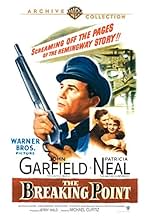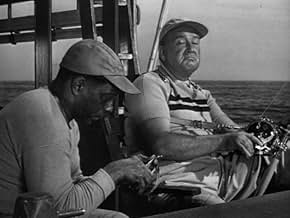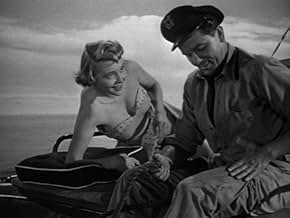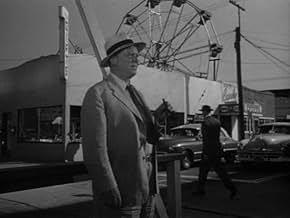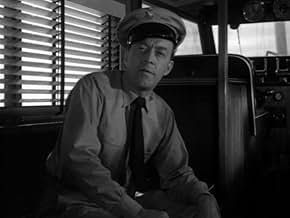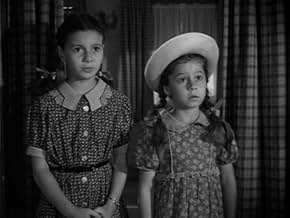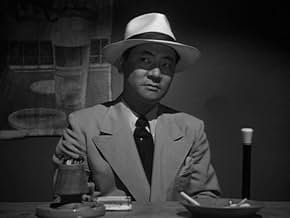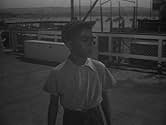IMDb-BEWERTUNG
7,5/10
4935
IHRE BEWERTUNG
Füge eine Handlung in deiner Sprache hinzuAn otherwise moral captain of a charter boat becomes financially strapped and is drawn into illegal activities in order to keep up payments on his boat.An otherwise moral captain of a charter boat becomes financially strapped and is drawn into illegal activities in order to keep up payments on his boat.An otherwise moral captain of a charter boat becomes financially strapped and is drawn into illegal activities in order to keep up payments on his boat.
- Regie
- Drehbuch
- Hauptbesetzung
- Auszeichnungen
- 4 wins total
John Alvin
- Reporter
- (Nicht genannt)
Chet Brandenburg
- Taxi Driver
- (Nicht genannt)
Peter Brocco
- Macho
- (Nicht genannt)
Mary Carroll
- Girl at Bar
- (Nicht genannt)
Spencer Chan
- 1st Chinese Immigrant
- (Nicht genannt)
John Close
- Deputy
- (Nicht genannt)
Empfohlene Bewertungen
This is a remake of TO HAVE AND HAVE NOT that supposedly from what I've read sticks closer to the Hemingway story. Garfield could play the strong but tormented guy like nobody's business, here however we have most of the information needed in understanding just what's eating at this guy, wearing him down and making him afraid. "A man alone hasn't got a chance," he keeps repeating. But Harry isn't alone. He's got a family that loves him, a plain but good woman he adores, and who adores him. A best friend who is his shipping mate, yet he still can't shake the feeling that somehow the universe is against him, working overtime. He's like a man that needs some spiritual guidance. Something is missing. On first viewing this plays like a well done yarn. On subsequent viewings however, this film begins to haunt. The characters and scenes play on a deeper, more meaningful level. The domestic scenes, usually the throwaway, boring parts of a story like this, become the rock and Garfield and Phylis Thaxter emit genuine emotion and affection for one another that is unusually realistic. Patricia Neal is the temptress here, and in an unusual move, we're not supposed to fall in love with her or maybe even like her, which is evident in how she's physically presented. Her haircut is really bad and she's basically unflatteringly lit and photographed. She too looks realistic: like a once beautiful creature who's been around the block too many times and is starting to look all used up.
Juano Hernandez rounds out the main players as Garfield's friend and shipmate. It was Garfield who insisted the character be a black man and had the relationship between the two beefed up. According to Garfield's daughter, the studio didn't like the idea and tried to talk him out of it, eventually giving up. This casting led to someone (director Michael Curtiz?)coming up with that final shot in the film that hits like a sucker punch to the gut, unexpected and unforgettable.
Watch this one a second time and see if you agree.
Juano Hernandez rounds out the main players as Garfield's friend and shipmate. It was Garfield who insisted the character be a black man and had the relationship between the two beefed up. According to Garfield's daughter, the studio didn't like the idea and tried to talk him out of it, eventually giving up. This casting led to someone (director Michael Curtiz?)coming up with that final shot in the film that hits like a sucker punch to the gut, unexpected and unforgettable.
Watch this one a second time and see if you agree.
I just saw this movie in the last week at a recent Film Noir Festival here in San Francisco. Garfield owns this role as a down on his luck captain of his boat. He is willing to take shady deals to make money for him and keep his family (his two young daughters) with money. His wife played by Phyllis Thaxter gives a fine turn as a wife and mother. Patricia Neal is smooth and dangerous in her role as a two timing blonde broad. The daughters that played the kids were effective and smart like their ages were depicted. Garfield's mate Wesley Park was very good in his role of Garfiled's suffering partner. The reptilian role of the attorney was convincing and nasty. The final minutes of the movie had me choked up with the performances from Garfield and Thaxter. Another great movie by Michael Curtiz. Why isn't this movie on DVD?
With the Depression, the so-called "upper class," the subject of so many plays and films, began to fade and be replaced by the work of playwrights such as Clifford Odets.
John Garfield was the type of leading man who came out of that kind of working man play -- more rugged than romantic, more blue collar than white collar, more at home in a leather jacket than a tuxedo. That leading man type would peak post-war with the likes of Dean, Brando, Steiger, Newman, McQueen, and others. But their predecessor was John Garfield.
Here he stars in his second-last film, as he would soon be blacklisted -- it's "The Breaking Point," based on the Hemingway novel "To Have and Have Not," but not really like the Bogart-Bacall film, which borrowed the title.
In "The Breaking Point," Garfield plays Harry Morgan, who runs a charter boat in California. He has a wife, Lucy (Phyllis Thaxter) and two daughters (Sherry Jackson, Donna Jo Boyce). Times are tough (the original novel took place during the Depression) and Harry is having trouble making enough money to pay off his boat and raise his family.
Lucy wishes her husband would work for his father on his lettuce farm in Salinas, but Harry says all he knows is boats.
Because he needs money, Harry agrees to carry out a shady deal, transporting Chinese to the United States. But when he is cheated out of most of his money, he returns the men where he picked them up. However, someone rats on him and he nearly loses his boat.
When the boat's owner threatens to take the boat for nonpayment, Harry agrees to another shady deal; this one proves more dangerous.
Very intense film which also stars Juano Hernandez, who was wonderful in so many films until his death in 1970; Patricia Neal in her "babe" days, as a former boat passenger who is attracted to Harry; and Wallace Ford, as a foolish man involved in nefarious schemes. William Campbell, whose big claim to fame was that he was married to JFK's girlfriend Judith Exton, plays a low-level criminal.
John Garfield gives a brilliant performance as a stubborn, intense, desperate man who doesn't know where to turn. His last movie, He Ran All the Way, was a B movie and a clear indication that, thanks to the Communist witch hunt, he was on his way out. He died two years later.
Beautifully directed by Michael Curtiz, the end of the movie is especially poignant.
John Garfield was the type of leading man who came out of that kind of working man play -- more rugged than romantic, more blue collar than white collar, more at home in a leather jacket than a tuxedo. That leading man type would peak post-war with the likes of Dean, Brando, Steiger, Newman, McQueen, and others. But their predecessor was John Garfield.
Here he stars in his second-last film, as he would soon be blacklisted -- it's "The Breaking Point," based on the Hemingway novel "To Have and Have Not," but not really like the Bogart-Bacall film, which borrowed the title.
In "The Breaking Point," Garfield plays Harry Morgan, who runs a charter boat in California. He has a wife, Lucy (Phyllis Thaxter) and two daughters (Sherry Jackson, Donna Jo Boyce). Times are tough (the original novel took place during the Depression) and Harry is having trouble making enough money to pay off his boat and raise his family.
Lucy wishes her husband would work for his father on his lettuce farm in Salinas, but Harry says all he knows is boats.
Because he needs money, Harry agrees to carry out a shady deal, transporting Chinese to the United States. But when he is cheated out of most of his money, he returns the men where he picked them up. However, someone rats on him and he nearly loses his boat.
When the boat's owner threatens to take the boat for nonpayment, Harry agrees to another shady deal; this one proves more dangerous.
Very intense film which also stars Juano Hernandez, who was wonderful in so many films until his death in 1970; Patricia Neal in her "babe" days, as a former boat passenger who is attracted to Harry; and Wallace Ford, as a foolish man involved in nefarious schemes. William Campbell, whose big claim to fame was that he was married to JFK's girlfriend Judith Exton, plays a low-level criminal.
John Garfield gives a brilliant performance as a stubborn, intense, desperate man who doesn't know where to turn. His last movie, He Ran All the Way, was a B movie and a clear indication that, thanks to the Communist witch hunt, he was on his way out. He died two years later.
Beautifully directed by Michael Curtiz, the end of the movie is especially poignant.
The Breaking Point (1950)
Forget for a second that this is a Hemingway story, or that it was more famously and loosely made into a movie ("To Have and Have Not)" with Bogart and Bacall in 1944.
Here was have John Garfield playing with great realism a boating man, Morgan, who has hit hard times. So he is tempted by an illegal run for some big money. And it goes badly. Then, to get out of that jam, he is drawn into yet another one, which goes even worse.
So this is really a story of a man against the odds. He's basically a good person, which we see in how he treats his partner, his wife, his kids. But it's partly because of those others that he feels he has to come through and make some money. In a way, this is what Hemingway's novel is all about--how a man copes with crisis. (This is always what Hemingway is about, in a way.) It's great starting material.
The two women in the story, made to look slightly similar, are key in a Hemingway kind of way, too, because a Hemingway man is essentially torn by love all his life. Morgan's wife is terrific in a simple, unexciting way, and when Patricia Neal appears very sexually hungry, Morgan at first is not interested. Neal's character is not quite a noir femme fatale, since she really wants nothing for herself, but is a distraction and siren.
The two of them are terrific. Around them are a whole swarm of characters, some with important roles and excellent character actors, but we really get inside the head of Garfield and we really feel the weirdly brazen and carefree intensity of Neal.
So why is this a forgotten film? For one, Garfield is a low key leading man. He always is. His effect is subtle. And Neal isn't a steaming hottie or an outrageous caricature like some leading (blonde) women in these crime films. And then, frankly, they don't totally have chemistry on screen, which is neither one's fault alone, and which isn't so inaccurate to the story.
And about Hemingway? The book is great. You have to like his style and his manly view, but if you can adapt to that, read it. Easy reading, too. And he set the scene in the waters between Florida and Cuba, which is where he lived and fished. The Bogart version was set in the war, working for the French Resistance in Europe. The Garfield version was set (and shot) in California, with a trip to Mexico. A later version (1958) is set in Florida.
This is actually a first rate movie. Part of the success depends on the writing-both Hemingway and the sharp, noir-influenced screenplay by Ranald MacDougall. Note that the photography is by the great Ted McCord (Sound of Music, East of Eden, etc.).
The plot has some deeply personal aspects, both with Morgan's wife and kids as they barely scrape by and with the temptation of the sort of femme fatale played with a cool sharpness by Patricia Neal. And it has a serious crime plot with several angles that develop and disperse and develop further. It moves from dark night scenes to open water scenes to a faked fog ending (a flaw, visually, because you can tell it's just been processed for lower contrast even though the sun is out).
The movie also has some aspects that strike me as socially relevant, starting with the smuggling of a group of Chinese people out of Mexico at the start and ending with the tragic dilemma of a little African-American boy left literally alone on a big open dock at the final fade. This last aspect (which I can't get specific about without spoiling something) points to one of the really big interpersonal parts of the film that is key, and that I wish had been developed just a hair more because it's so key.
On my third viewing, I continue to like it a lot. See it.
Forget for a second that this is a Hemingway story, or that it was more famously and loosely made into a movie ("To Have and Have Not)" with Bogart and Bacall in 1944.
Here was have John Garfield playing with great realism a boating man, Morgan, who has hit hard times. So he is tempted by an illegal run for some big money. And it goes badly. Then, to get out of that jam, he is drawn into yet another one, which goes even worse.
So this is really a story of a man against the odds. He's basically a good person, which we see in how he treats his partner, his wife, his kids. But it's partly because of those others that he feels he has to come through and make some money. In a way, this is what Hemingway's novel is all about--how a man copes with crisis. (This is always what Hemingway is about, in a way.) It's great starting material.
The two women in the story, made to look slightly similar, are key in a Hemingway kind of way, too, because a Hemingway man is essentially torn by love all his life. Morgan's wife is terrific in a simple, unexciting way, and when Patricia Neal appears very sexually hungry, Morgan at first is not interested. Neal's character is not quite a noir femme fatale, since she really wants nothing for herself, but is a distraction and siren.
The two of them are terrific. Around them are a whole swarm of characters, some with important roles and excellent character actors, but we really get inside the head of Garfield and we really feel the weirdly brazen and carefree intensity of Neal.
So why is this a forgotten film? For one, Garfield is a low key leading man. He always is. His effect is subtle. And Neal isn't a steaming hottie or an outrageous caricature like some leading (blonde) women in these crime films. And then, frankly, they don't totally have chemistry on screen, which is neither one's fault alone, and which isn't so inaccurate to the story.
And about Hemingway? The book is great. You have to like his style and his manly view, but if you can adapt to that, read it. Easy reading, too. And he set the scene in the waters between Florida and Cuba, which is where he lived and fished. The Bogart version was set in the war, working for the French Resistance in Europe. The Garfield version was set (and shot) in California, with a trip to Mexico. A later version (1958) is set in Florida.
This is actually a first rate movie. Part of the success depends on the writing-both Hemingway and the sharp, noir-influenced screenplay by Ranald MacDougall. Note that the photography is by the great Ted McCord (Sound of Music, East of Eden, etc.).
The plot has some deeply personal aspects, both with Morgan's wife and kids as they barely scrape by and with the temptation of the sort of femme fatale played with a cool sharpness by Patricia Neal. And it has a serious crime plot with several angles that develop and disperse and develop further. It moves from dark night scenes to open water scenes to a faked fog ending (a flaw, visually, because you can tell it's just been processed for lower contrast even though the sun is out).
The movie also has some aspects that strike me as socially relevant, starting with the smuggling of a group of Chinese people out of Mexico at the start and ending with the tragic dilemma of a little African-American boy left literally alone on a big open dock at the final fade. This last aspect (which I can't get specific about without spoiling something) points to one of the really big interpersonal parts of the film that is key, and that I wish had been developed just a hair more because it's so key.
On my third viewing, I continue to like it a lot. See it.
No one played the haunted/hunted character better than John Garfield (Humphrey Bogart is a close second). Here, Garfield is a boat captain that gets in way over his head. The thing with Garfield's characters, is that even though the audience sympathizes with his plight, the character always brings it on himself. With Garfield's usual acerbic delivery, his Harry Morgan is hard to like but when he is with his family, one sees that he is basically a headstrong but good guy. Even though Michael Curtiz directed this, the tone and especially the ending shot kept reminding me of Fritz Lang. I think this film should be commended for the ending, which although a somewhat happy one, reminds the audience of the affect of one's actions on everyone. This generally was ignored in a lot of the crime dramas from the 30's to the 60's. My only complaint is the Patricia Neal character seemed tacked on for romance sake. She didn't add much and certainly didn't have an impact on the main thrust of the story. But that is a minor quibble. Another gem for one of the move overlooked actors - John Garfield.
Wusstest du schon
- WissenswertesAccording to TCM's Eddie Muller, John Garfield thought this was his best performance and that it was the film of which he was most proud.
- PatzerWhen she first steps onto the boat, Patricia Neal's voice is heard saying "we're off to sunny Mexico," but her lips aren't moving.
- Zitate
Harry Morgan: You know, my wife dyed her hair.
Leona Charles: Coincidentally I've been thinking of letting mine grow out. Speaking of coincidences, I live in Number Seven. My friends just kick the door open.
- Crazy CreditsTHE END close out. All lettering aligned and centered except for the line beneath Warner Bros. that begins PICTURES. It's left registered with whatever wording that followed it 'air brushed' over using the lower right drop shadow pattern leaving a Warner Bros. Pictures _?_?_?_?_ mystery.
- VerbindungenFeatured in The John Garfield Story (2003)
- SoundtracksPlease Don't Talk About Me When I'm Gone
(uncredited)
Music by Sam H. Stept
Lyrics by Sidney Clare
Sung by Patricia Neal in the bar
Top-Auswahl
Melde dich zum Bewerten an und greife auf die Watchlist für personalisierte Empfehlungen zu.
- How long is The Breaking Point?Powered by Alexa
Details
- Laufzeit
- 1 Std. 37 Min.(97 min)
- Farbe
- Seitenverhältnis
- 1.33 : 1
Zu dieser Seite beitragen
Bearbeitung vorschlagen oder fehlenden Inhalt hinzufügen



